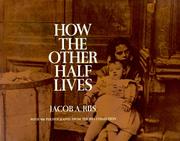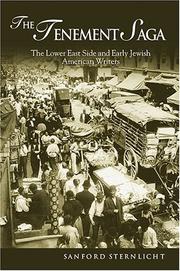| Listing 1 - 3 of 3 |
Sort by
|

ISBN: 0486220125 9780486220123 Year: 1971 Publisher: New York (N.Y.) Dover
Abstract | Keywords | Export | Availability | Bookmark
 Loading...
Loading...Choose an application
- Reference Manager
- EndNote
- RefWorks (Direct export to RefWorks)
In How the Other Half Lives, New Yorkers read with horror that three-quarters of the residents of their city were housed in tenements and that in those tenements rents were substantially higher than in better sections of the city. In his book Riis gave a full and detailed picture of what life in those slums was like, how the slums were created, how and why they remained as they were, who was forced to live there, and offered suggestions for easing the lot of the poor. Riis originally documented all his studies with photographs. However, since the half-tone technique of photo reproduction had not been perfected, the original edition included mainly reductions in sketch-form of Riis' photographs. These could not begin to capture what Riis' sensitive camera caught on film. The anguish and the apathy, the toughness and the humiliation of the anonymous faces is all but obliterated in the sketches. This Dover edition includes fully 100 photographs, many famous, and many less familiar, from the Riis collection of the City Museum, and their inclusion here creates a closer conformity to Riis' intentions than did the original edition. Jacob Riis was one of the very few men who photographed the slums of New York at the turn of the century, when as many as 300,000 people per square mile were crowded into the tenements of New York's Lower East Side. The filth and degradation made the area a hell for the immigrants forced to live there. Riis was one of those immigrants, and, after years of abject poverty, when he became a police reporter for the New York Tribune, he exposed the shameful conditions of life with which he was all too familiar. Today, he is best remembered as a compassionate and effective reformer and as a pioneer photo-journalist.
Poor --- -Tenement houses --- -Kunst --- Fotografie --- Armoede --- Tenements (Apartment houses) --- Apartment houses --- Disadvantaged, Economically --- Economically disadvantaged --- Impoverished people --- Low-income people --- Pauperism --- Poor, The --- Poor people --- Persons --- Social classes --- Poverty --- Economic conditions --- Tenement houses --- CDL --- 77.071 RIIS --- Kunst

ISBN: 1282269666 9786612269660 0299204839 9780299204839 0299204804 9780299204808 0299204847 9780299204846 9781282269668 6612269669 Year: 2004 Publisher: Madison, Wis.
Abstract | Keywords | Export | Availability | Bookmark
 Loading...
Loading...Choose an application
- Reference Manager
- EndNote
- RefWorks (Direct export to RefWorks)
American literature --- Authors, American --- Jewish authors --- Jews --- Judaism and literature --- Tenement houses --- Immigrants in literature. --- Jews in literature. --- Immigrants in literature --- Jews in literature --- American Literature --- English --- Languages & Literatures --- Tenements (Apartment houses) --- Apartment houses --- Literature and Judaism --- Literature --- Hebrews --- Israelites --- Jewish people --- Jewry --- Judaic people --- Judaists --- Ethnology --- Religious adherents --- Semites --- Judaism --- Authors --- English literature --- Agrarians (Group of writers) --- History and criticism. --- Homes and haunts --- Intellectual life. --- History and criticism --- Intellectual life --- Lower East Side (New York, N.Y.) --- LES (New York, N.Y.) --- In literature. --- History. --- East Side, Lower (New York, N.Y.)
Book
Year: 2021 Publisher: Basel, Switzerland MDPI - Multidisciplinary Digital Publishing Institute
Abstract | Keywords | Export | Availability | Bookmark
 Loading...
Loading...Choose an application
- Reference Manager
- EndNote
- RefWorks (Direct export to RefWorks)
The Life cycle cost (LCC) method makes it possible for the whole life performance of buildings and other structures to be optimized. The introduction of the idea of thinking in terms of a building life cycle resulted in the need to use appropriate tools and techniques for assessing and analyzing costs throughout the life cycle of the building. Traditionally, estimates of LCC have been calculated based on historical analysis of data and have used deterministic models. The concepts of probability theory can also be applied to life cycle costing, treating the costs and timings as a stochastic process. If any subjectivity is introduced into the estimates, then the uncertainty cannot be handled using the probability theory alone. The theory of fuzzy sets is a valuable tool for handling such uncertainties. In this Special Issue, a collection of 11 contributions provide an updated overview of the approaches for estimating the life cycle cost of buildings.
dynamic analysis --- steel frames --- Tuned Mass Damper --- optimization --- drift ratio --- sustainable construction industry --- lifecycles --- European Union Member States --- complex evaluation --- multiple criteria analysis --- COPRAS and INVAR methods --- success and image of a country --- marketing --- residential buildings --- defects --- intensity --- reliability --- technical wear --- railway infrastructure --- occurrences --- socioeconomic impact --- economic evaluation --- CBA --- life cycle --- investment project --- probability distribution --- sensitivity analyses --- risk assessment --- tenement houses --- damage --- maintenance --- fuzzy sets --- Bayes conditional probability --- substitution --- operation and maintenance phase --- cause–effect relationships --- historical buildings --- implementation factors --- information and communication technology --- life cycle costs --- buildings --- bidding decision --- LCC criterion --- price criterion --- construction --- statistical method --- classification --- probability of winning --- risk identification --- MCDM --- critical risk factors --- commercial and recreational complex building projects
| Listing 1 - 3 of 3 |
Sort by
|

 Search
Search Feedback
Feedback About UniCat
About UniCat  Help
Help News
News